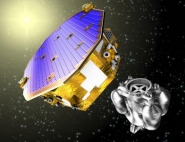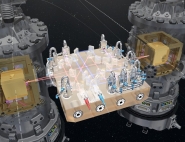Mission

Science Objectives
LISA Pathfinder is intended to demonstrate the key technologies for the collaborative ESA/NASA LISA mission. To this end, LISA Pathfinder will accommodate a LISA Technology Package (LTP), a set of micro-propulsion thrusters and drag-free control software provided by European institutes and industry and a Disturbance Reduction System (DRS) composed of micro-propulsion thrusters and drag-free control software, provided by NASA.
The mission goals for the LTP are:
- Demonstrate drag-free and attitude control in a spacecraft with two proof masses in order to isolate the masses from inertial disturbances
- Performance Required
3x10-14 ms-2 Hz-1/2, rising with frequency squared (f²) above 3 mHz, over the measurement bandwidth of 1-30 mHz - LISA Performance Required
3x10-15 ms-2 Hz-1/2, rising with frequency squared (f²) above 3 mHz, over the measurement bandwidth of 0.1 mHz - 1 Hz
- Performance Required
- Demonstrate the feasibility of performing laser interferometry in the required low-frequency regime with a performance as close as possible to 10-12 m Hz-1/2 in the 1-30 mHzfrequency band, as required for the LISA mission
- Assess the longevity and reliability of the capacitive sensors, thrusters, lasers and optics in the space environment.
Mission
Launch
LISA Pathfinder was carried into orbit from Europe's spaceport in French Guiana by an ESA Vega launch vehicle on 3 December 2015. Vega placed the spacecraft in an elliptical parking orbit around the Earth with perigee at 200 km, apogee at 1,620 km and an inclination of 5.3°, aligned so that the spacecraft can then use its own expendable propulsion system to transition to its final operational orbit, at L1.
The velocity increment required for apogee-raising and injection into the operational orbit is about 3,100 ms-1. As the spacecraft transferred to the operational orbit, the propulsion module separated from the science spacecraft prior to drag-free operations, to prevent disturbances that would be generated by the residual propellants acting on the inertial sensors.
Operational Orbit
![]()
LISA Pathfinder transfer and operational orbit. Credit: Astrium
The operational orbit for LISA Pathfinder is a 500,000 km x 800,000 km Lissajous orbit around the first Lagrange point (L1) of the Sun-Earth system. The L1 Lissajous orbit has been chosen because it is an intrinsically 'quiet' place in space, far away from massive bodies, which induce tidal forces on the spacecraft, has constant illumination from the Sun, and has a quasi-constant distance from Earth for communication. This orbit fulfils the stringent requirements of LISA Pathfinder concerning thermal and gravitational stability.
This Lissajous orbit, with aperiod of 180 days, is unstable so periodic stationkeeping manoeuvres will be required, amounting to about 1.8 ms-1 per year. These manoeuvres will be performed using the cold gas thrusters that make up the spacecraft's micro-propulsion system.

